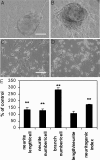Improved spatial learning performance of fat-1 mice is associated with enhanced neurogenesis and neuritogenesis by docosahexaenoic acid
- PMID: 19549874
- PMCID: PMC2708766
- DOI: 10.1073/pnas.0904835106
Improved spatial learning performance of fat-1 mice is associated with enhanced neurogenesis and neuritogenesis by docosahexaenoic acid
Abstract
Docosahexaenoic acid (DHA), an n-3 long chain polyunsaturated fatty acid (LC-PUFA), highly enriched in the central nervous system, is critical for brain development and function. It has been shown that DHA deficiency impairs cognitive performance whereas DHA supplementation improves the condition. However, the mechanisms underlying the role of DHA in brain development and function remain to be elucidated. By using transgenic fat-1 mice rich in endogenous n-3 PUFA, we show that increased brain DHA significantly enhances hippocampal neurogenesis shown by an increased number of proliferating neurons and neuritogenesis, evidenced by increased density of dendritic spines of CA1 pyramidal neurons in the hippocampus. Concurrently, fat-1 mice exhibit a better spatial learning performance in the Morris water maze compared with control WT littermates. In vitro experiments further demonstrate that DHA promotes differentiation and neurite outgrowth of neuronal cells derived from mouse ES cells and increases the proliferation of cells undergoing differentiation into neuronal lineages from the ES cells. These results together provide direct evidence for a promoting effect of DHA on neurogenesis and neuritogenesis and suggest that this effect may be a mechanism underlying its beneficial effect on behavioral performance.
Conflict of interest statement
The authors declare no conflict of interest.
Figures






References
-
- Martin RE, Bazan NG. Changing fatty acid content of growth cone lipids prior to synaptogenesis. J Neurochem. 1992;59:318–325. - PubMed
-
- Crawford MA. Docosahexaenoic acid in neural signaling systems. Nutr Health. 2006;18:263–276. - PubMed
-
- Birch EE, et al. Visual maturation of term infants fed long-chain polyunsaturated fatty acid-supplemented or control formula for 12 mo. Am J Clin Nutr. 2005;81:871–879. - PubMed
-
- Birch EE, Garfield S, Hoffman DR, Uauy R, Birch DG. A randomized controlled trial of early dietary supply of long-chain polyunsaturated fatty acids and mental development in term infants. Dev Med Child Neurol. 2000;42:174–181. - PubMed
Publication types
MeSH terms
Substances
Grants and funding
LinkOut - more resources
Full Text Sources
Other Literature Sources
Molecular Biology Databases
Miscellaneous

